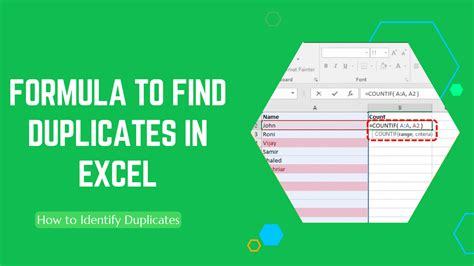How To Find Non Duplicate Values In Excel Using Formula
Ronan Farrow
Feb 24, 2025 · 3 min read

Table of Contents
How to Find Non-Duplicate Values in Excel Using Formulas
Finding unique values in a large Excel dataset can be a tedious task. Manually searching through rows and columns is inefficient and prone to errors. Fortunately, Excel offers several powerful formulas that can quickly and accurately identify non-duplicate values. This guide will walk you through some of the most effective methods.
Understanding the Challenge: Duplicate vs. Non-Duplicate Values
Before diving into the formulas, let's define our terms. A duplicate value is a value that appears more than once in a dataset. A non-duplicate value (or unique value) appears only once. Our goal is to extract these unique values.
Method 1: Using COUNTIF and FILTER (Excel 365 and later)
This method leverages the power of COUNTIF to count occurrences and FILTER to extract the results. It's efficient and straightforward.
Steps:
-
Assume your data is in column A, starting from A1.
-
Use the following formula in a separate cell (e.g., B1):
=FILTER(A:A,COUNTIF(A:A,A:A)=1) -
Explanation:
COUNTIF(A:A,A:A)counts how many times each value in column A appears in column A.COUNTIF(A:A,A:A)=1creates an array of TRUE/FALSE values. TRUE indicates a unique value (appears only once).FILTER(A:A,COUNTIF(A:A,A:A)=1)filters column A, keeping only the rows where the corresponding value in the TRUE/FALSE array is TRUE (i.e., the unique values).
This formula will neatly list all non-duplicate values in column B.
Method 2: Using UNIQUE (Excel 365 and later)
The UNIQUE function provides a more concise way to extract unique values.
Steps:
-
Assume your data is in column A, starting from A1.
-
Use the following formula in a separate cell (e.g., B1):
=UNIQUE(A:A) -
Explanation:
The
UNIQUEfunction directly returns an array containing only the unique values from the specified range. It's incredibly efficient and easy to understand.
This formula lists all unique values from column A in column B. This method doesn't explicitly identify non-duplicate values, but effectively provides the same result.
Method 3: Advanced Filtering (All Excel Versions)
For older Excel versions lacking FILTER and UNIQUE, advanced filtering offers a viable alternative.
Steps:
- Select your data range (e.g., A1:A10).
- Go to Data > Advanced.
- Select "Copy to another location."
- Check "Unique records only."
- Specify the output range (e.g., B1).
- Click OK.
This will copy only the unique values from your selected range to the specified output range.
Choosing the Right Method
- Excel 365 and later: Use
UNIQUEfor its simplicity and efficiency.FILTERwithCOUNTIFoffers more control and understanding of the process. - Older Excel Versions: Advanced filtering provides a reliable method to find unique values.
Remember to adapt the column references (e.g., A:A) to match your actual data location. These formulas provide efficient ways to manage and analyze your Excel data, saving time and improving accuracy. Understanding the underlying logic of these functions empowers you to tackle more complex data manipulation tasks effectively.
Featured Posts
Also read the following articles
| Article Title | Date |
|---|---|
| How To Find Non Duplicate Values In Excel Using Formula | Feb 24, 2025 |
| How To Buy Bitcoin Etf In Uk | Feb 24, 2025 |
| How To Add Signature In Outlook Event | Feb 24, 2025 |
| How To Find Acceleration Position Vs Time Graph | Feb 24, 2025 |
| How To Make Money Quick In Gta 5 | Feb 24, 2025 |
Latest Posts
Thank you for visiting our website which covers about How To Find Non Duplicate Values In Excel Using Formula . We hope the information provided has been useful to you. Feel free to contact us if you have any questions or need further assistance. See you next time and don't miss to bookmark.
